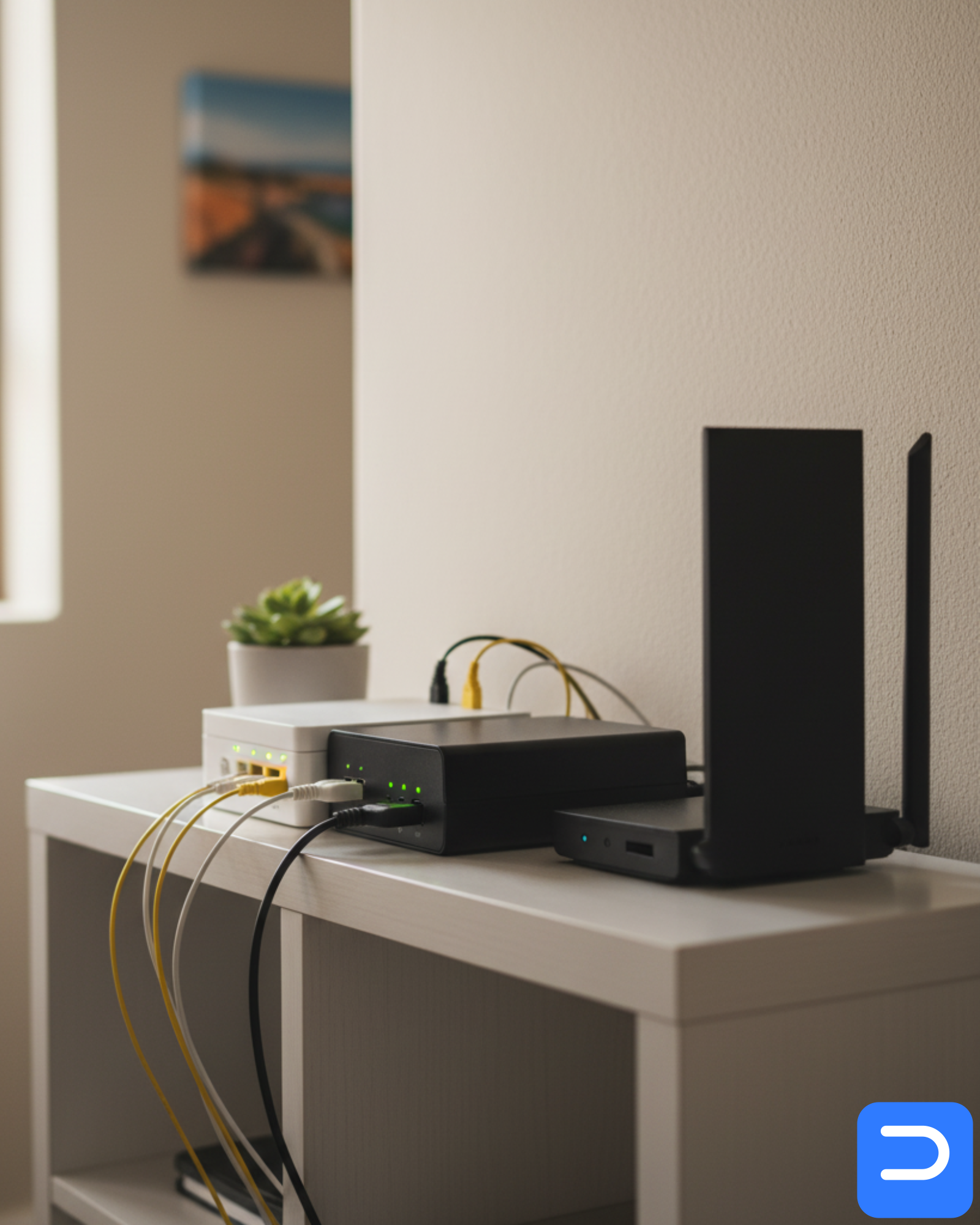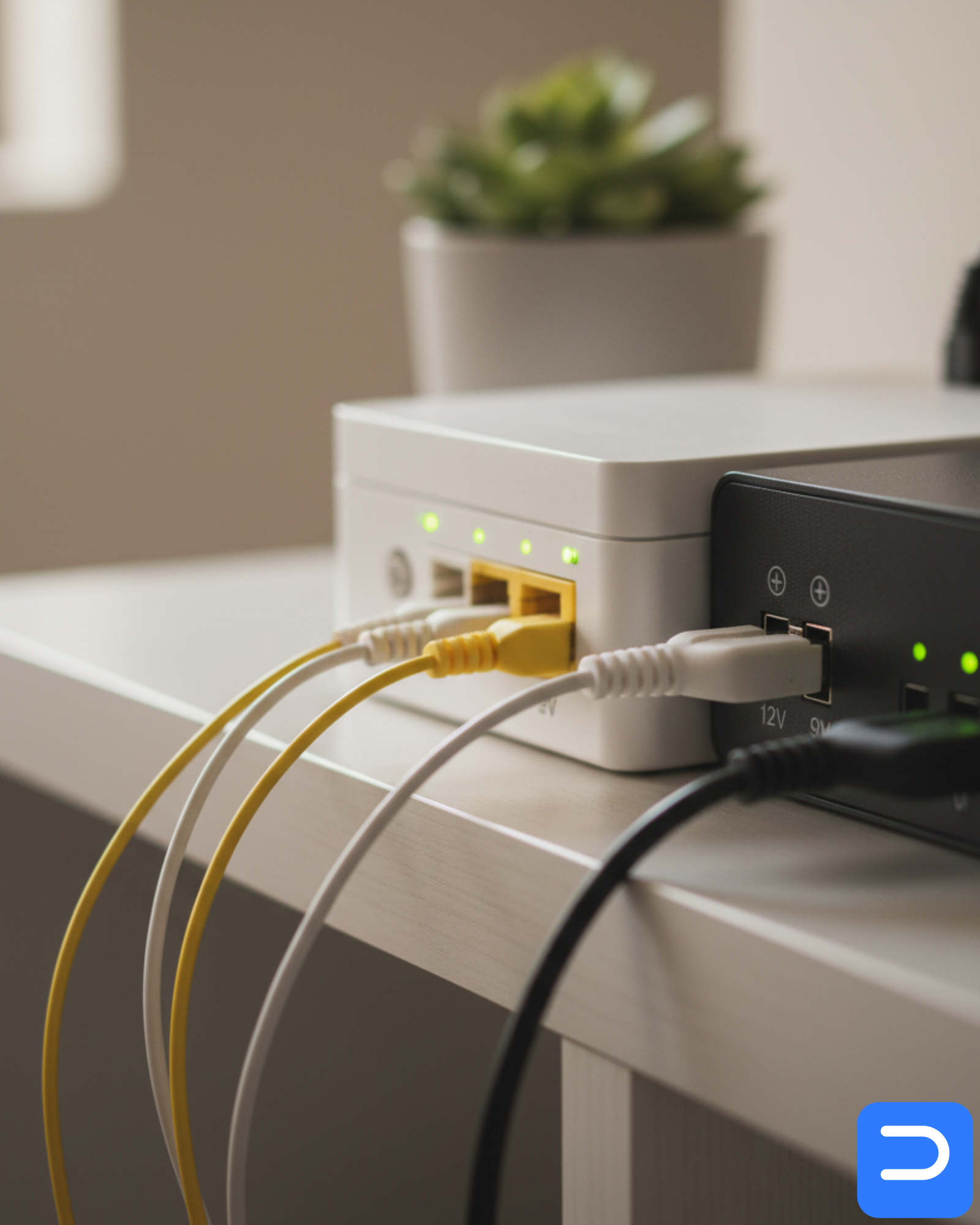Stellenbosch Load-Shedding Survival: Keep Your Laptop & Wi-Fi Running
Keep working during load-shedding in Stellenbosch with DC-UPS tips, safe battery care, and our resilience checks for laptops and routers.
· Digissential Team · 5 min read
TL;DR: A small DC-UPS keeps your ONT + router alive through load-shedding; a healthy, cool laptop battery handles the rest. If a battery is swollen or weak, stop using it and book a safe replacement. We can spec, install, and test your setup with clear ZAR guidance.

Stellenbosch students and SMEs know the drill: when the power trips, productivity drops. The real risk is missed assignments, offline card readers, and meetings that stall. The good news is you don’t need a generator. A DC-UPS for Wi-Fi and a resilient laptop setup cover most outages—quietly and safely.
Below you’ll find the simple sizing math, battery safety notes, runtime targets, and local ZAR expectations. Need help today? We can handle spec → install → test and leave you with clear labels and an outage playbook.
What you’ll learn (quick wins)
- How to size a DC-UPS for ONT + router with a realistic 3–4 hour target.
- The safe way to run laptops during outages (battery health, thermals, power plans).
- When to buy a bigger pack vs when to fix the bottleneck (old battery, dust, mis-set power profiles).
- Where Digissential steps in: selection, installation, testing, and documentation.
Identify the problems (you’ll recognise these)
- Wi-Fi dies instantly when load-shedding starts; mobile data is congested and expensive.
- Laptop battery drains fast or shuts down at 20–30%.
- Random crashes under Teams/Zoom/gaming due to thermal throttling or weak batteries.
- Different voltages for ONT/router (e.g., 12V and 9V) mean USB power banks won’t work.
- Unsafe adapters create heat risk—especially with swollen cells.
Safe steps (do this in order)
- Map your loads. Flip your router and ONT over and note V and A/W. If you see amps only, V × A = W. Typical: ONT ≈ 6–8W; router ≈ 8–12W.
- Add watts to get your total load. Example: ONT 7W + router 10W = 17W.
- Match voltages & polarity. Choose a DC-UPS with the exact rails (e.g., 12V + 9V) and the right barrel sizes.
- Pick capacity by runtime. Runtime (h) ≈ Battery Wh ÷ (Load W × 1.2). For 17W and a 90Wh pack: 90 ÷ (17 × 1.2) ≈ 4.4 h.
- Cable it right. Use snug barrel tips, short cables, and labelled splitters; avoid daisy chains.
- Test under load. Unplug mains; run a speed test; confirm both ONT and router stay online through a full stage.
- Harden your laptop. See the resilience checklist below (battery, thermals, power plan, offline files).
- Plan B. Save your phone hotspot APN and a small data bundle as fallback—not your primary.
These steps mirror the HowTo block in the front-matter so your schema stays truthful.
Do-nots (safety first)
- Don’t keep using a swollen or hot battery. Power down; book a safe replacement and lawful disposal.
- Don’t “guess” voltages—overvoltage bricks gear.
- Don’t put DC-UPS units in enclosed cupboards or under blankets—heat kills batteries.
- Don’t expect a tiny UPS to drive gaming loads; you’ll brown-out the system.
Laptop resilience checklist (fast wins)
Battery health
- If the laptop dies quickly or jumps from 30% → 0%, the pack is likely worn. Book Battery Replacement (Labour) to restore usable runtime.
Thermals
- Dust and aged thermal paste force throttling and shutdowns. If fans howl or the palm rest heats up, schedule a clean and paste.
Power plan & apps
- Windows: “Balanced”, lower brightness, turn off RGB and heavy background sync.
- macOS: enable Low Power Mode for multi-hour sessions.
Data hygiene
- Enable Offline Files (or mark key folders Available Offline in OneDrive/Drive). Load-shedding isn’t the time to discover missing files.
DC-UPS vs AC UPS: which and when?
- DC-UPS (best for Wi-Fi): Powers 12V/9V gear directly—efficient, cool, quiet.
- AC UPS: Ideal for desktops/monitors, but inefficient for tiny router/ONT loads; fan noise and heat possible.
- Hybrid: DC-UPS for Wi-Fi + internal laptop battery (healthy) or a small AC UPS if you must drive an external display.
Time & cost in Stellenbosch (realistic bands)
- Wi-Fi/Network Setup (remote or in-shop): ≈ R350 for configuration, security, optimisation (hardware separate).
- Battery Replacement (Labour): ≈ R450 (labour only; we quote the correct battery for your model).
- On-Site Surcharge (within 20 km): ≈ R300 for travel/logistics to install and test at your premises.
- Remote Support Setup: ≈ R150 to ready Quick Assist/AnyDesk so we can help during outages.
- After-Hours/Emergency Labour: available; billed at published rates.
Hardware (DC-UPS units, cables, splitters) is quoted per model. We supply the correct barrel tips, label everything, and leave a one-page outage card.
When to stop DIY and call us
- Swollen, leaking, or hissing battery (immediate hazard).
- Voltage or polarity uncertainty on ONT/router labels.
- Repeated shutdowns on battery (likely pack wear or thermal fault).
- Wi-Fi drops despite “perfect” settings (could be interference, failing PSU, bad ONT).
Book help (fast)
FAQs
Q: Can I power my laptop from the same DC-UPS as the router?
A: No. Laptops need different power delivery. Keep your laptop on its own battery or use a small AC UPS if you require an external display.
Q: How many hours do I really need?
A: One full stage (2 h) minimum; 3–4 h is a stress-free buffer for staggered schedules.
Q: Will a bigger DC-UPS fix short laptop runtime?
A: No—DC-UPS feeds ONT/router. Short laptop runtime means battery replacement or thermal service.
Q: Do you install for student digs and small offices?
A: Yes. We bring the right tips, label cables, test failover, and document the setup for quick troubleshooting.
Compliance & trust
Updated on 2025-09-22.
